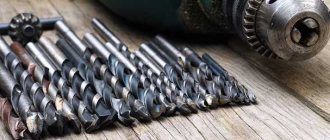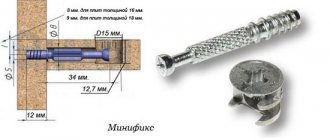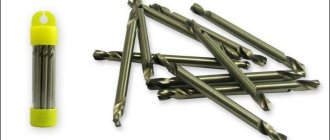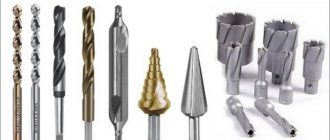Types of drills
The ideal drilling result depends not only on the professionalism and experience of the master, but also on the correct selection of the drill. The right tool will make the job much easier. Types of drills for metal surfaces differ in the type of configuration and the material from which they are made.
1. Twist drills are standard cylindrical products. They reach 80 mm in diameter. Made from high quality steel. Their design is such that the working surfaces are sharpened at an angle of 118 degrees. They are needed for almost all basic drilling work in metal. This is a versatile, durable tool.
2. Conical (or stepped) drills - are made in the form of cones with a stepped surface (spiral). They can easily drill a two-millimeter hole. They are also used to correct small defective holes that were formed as a result of poor performance of another tool.
3. Core drills are serrated hollow bits. They are also called annular cutters. The craftsman needs them to work with thin metal to make neat holes up to 30 mm. This tool can drill to great depths, due to the fact that the chips pass into the cavity of the crown.
4. Feather (flat) drills consist of replaceable working plates. They are designed to drill perfect deep holes in metal of any strength. The peculiarity of this type is that the flat drill practically does not distort during drilling. In addition, they are the cheapest, so they attract the attention of craftsmen.
Depending on the production material, drills are divided into cobalt and carbide. The first ones are made of cobalt. The second ones are made of high-strength alloys. — Cobalt drills are used at high temperatures, as they do not lose their qualities. Cobalt alloyed high speed steel tools allow you to work with very tough materials and highly tough metal products. Cobalt drills have an average price, but their quality and performance fully justify it. — Carbide drills have high cutting edge hardness. The equipment itself is usually made of simple steel for metalworking tools. And the plates are made of carbide alloy. Such models are needed for drilling products made of particularly strong materials of great thickness. The peculiarity of a carbide drill is that it can self-sharpen during operation.
Drill design
It is easier to understand the types of drills if you know the design of the standard product. It consists of the following elements:
- paws;
- shank;
- necks;
- cutting part.
The largest area is occupied by the cutting part. In standard products it has a spiral shape with two edges. There is also a groove through which chips are removed.
Reference! In high-quality equipment, all elements are made with high precision milling and grinding.
Drills, their types and types, an overview of a small part of our collection
Marking features
Markings on drills depend on their technical properties and country of manufacture. Russian GOST requires markings on all drills with a diameter of two centimeters and above. It usually contains basic information about the product: the grade of steel and the diameter of the drill. The marking is located on the shank of the cutting tool. On domestically produced instruments you can see markings of this type: “Р6М5К”. This is a formula in which each symbol is detailed information about the drill. This marking, for example, means that the product is made of high-speed steel (P), the tungsten content in it is six percent (6), molybdenum - five percent (M5) and five percent cobalt (K5). Foreign-made drills bear the HSS marking and additional designations, which, just like those of domestic manufacturers, indicate the characteristics of the product. For example, "HSS-4241" means that this model is suitable for working with aluminum.
Marking of drills according to GOST
The marking of products for drilling is regulated by GOST 2034-80. This document stipulates that equipment whose diameter does not reach 2 mm is not applied to the drill. Information is indicated only on the packaging label.
Products with a diameter of 2-3 mm are marked on the shank indicating the diameter and steel grade. Encryption of equipment whose diameter exceeds 3 mm includes the following information:
- options;
- trademark;
- metal grade;
- strength class.
The metal grade is indicated in the domestic GOST version (for example, R6M7K6), or international (HSS). Information about additives (Co, Ni, Ti, etc.) can also be supplemented.
International standard color coding
| Color | Group | Processed materials |
| Golden | S | Heat-resistant alloys with the addition of titanium, cobalt, iron, nickel. |
| Green | N | Duroplasts, thermoplastics. Non-ferrous metals, alloys made from them. |
| Grey | H | Hard grades of hardened steel. |
| Red | K | Different grades of cast iron. |
| Blue | P | Steel for castings, some types of corrosion-resistant steel, carbon steel, tool steel. Alloyed. |
| Yellow | M | Austenitic steel is corrosion-resistant, some types of non-magnetic steel are wear-resistant. |
Classification by color
By color you can determine the characteristics of the tool: strength, durability, purpose. Drills are available in three colors: gray, black and gold. Gray drills are among the simplest, cheapest and most short-lived. They do not have a protective coating, so their performance characteristics are quickly lost during operation. They are not suitable for high temperatures or heavy mechanical stress. But they are often used as a one-time use for simple work.
Black drills are treated with high temperature steam during manufacturing. Thanks to this treatment, the material is hardened and becomes durable. They wear out less and last longer than gray ones.
Golden drills can be lighter and more saturated. Light yellow very durable. They are made from high-speed steel using heat treatment technology. Bright gold cutting tools are even more durable than light gold ones. They have a titanium nitride coating. When drilling a hole, the gold drill experiences almost no friction force, which significantly extends its service life.
Manufacturing materials and coatings
The main materials for the manufacture of working parts of monolithic drilling tools are high-speed steels and hard alloys.
Steels with tungsten or tungsten-molybdenum alloys are most often used as high-speed cutters. The latter are also used in a version with the addition of cobalt. Hard alloys, which are produced by powder metallurgy methods, are more durable, stronger and heat-resistant than high-speed steels. They usually contain several refractory metals such as tungsten, titanium, cobalt and tantalum. Some products designed to perform several technological operations in one tool installation (for example, a combination drill) may include components made from different tool materials. To improve the performance of metal drills, their surfaces are subjected to additional processing or coated with hard metal compounds. The most common processing methods that increase the strength and wear resistance of tools are cyanidation and sulfidation. And for protective coatings, titanium carbonitride (TiCN), including alloyed aluminum (TiAlN), is usually used.
Classification by size
Currently, drills for working with metal are produced in different sizes to work with products of any thickness. Modern production classifies cutting tools in three working sizes:
short series drills - their minimum length is 20 mm, maximum - 130 mm; diameter ranges from 0.3 to 20 mm.
elongated - produced in lengths from 19 to 205 mm and diameters from 0.3 to 20 mm.
long series drills - reach a length of 254 mm, minimum diameter - 1 mm (maximum - 20 mm). The long model is convenient for working with products that are thick and durable. Short cutting tools are used to drill neat, uniform holes in a thin product (for example, a metal plate).
The best metal drill sets
Knowing thoroughly all the nuances of the types of this tool, materials of manufacture, design and type, we suggest considering the rating of metal drills, which will show the best models that have proven themselves well among users. The TOP is compiled both according to the characteristics of the product and taking into account customer reviews.
Extreme2 29 pcs. DeWALT DT 7926
A set from an American manufacturer, manufactured at production facilities in Germany. Contains 29 units at once with a diameter from 1 to 13 mm. In addition to solid values of 1, 2, 3 mm, there are intermediate values of 1.5, 2.5 mm, etc., which cover all the needs when working with metal and creating various holes. The cylindrical shank is equipped with three edges that improve fixation in the chuck.
Watch the product video
+ Pros Extreme2 29 pcs. DeWALT DT 7926
- Convenient three-section case with labels for each drill.
- Fast drilling.
- Long retention of sharpness.
- The marking is above the working area, so you can always read what diameter is indicated.
— Cons Extreme2 29 pcs. DeWALT DT 7926
- You need to carefully inspect the drills when purchasing - sometimes you come across used ones.
- Some drills are marked HHS, although the box says HHS-G.
- Thin diameters get very hot during operation - some even become red hot.
- A complex sharpening that is difficult to correct yourself.
Conclusion. This is an excellent choice for professional use with regular drilling in stainless steel.
AEG HSS-R (19 pcs; 2-10 mm)
A relatively inexpensive set of 19 units with a diameter from 2 to 10 mm. The steel is steam treated, so the drills are black.
Watch the product video
+ Pros HSS-R (19 pcs; 2-10 mm) AEG
- A convenient case with signed symbols and a durable seat for each element.
- They even drill into Soviet steel.
- The sharpness remains well despite frequent use.
- The box has a lockable second compartment for small items.
— Cons HSS-R (19 pcs; 2-10 mm) AEG
- The 10 mm diameter has a large angle of attack, so pre-drilling with a smaller drill is required, otherwise you can waste time or damage the equipment.
- You can’t put too much pressure on them and move the drill to the side, because they will break off.
- There is no 11-13 mm diameter for inserting locks and other similar work.
Conclusion. This is the best choice for home use so you don't have to buy these sets every year. It will last a long time and the tips will not have to be sharpened often.
Metabo (1-13 mm; HSS-G)
Products from a German manufacturer, containing 25 pieces per set. Features a metal case and convenient removal of drills. Manufactured using polishing to increase edge strength.
Watch the product video
+ Pros Metabo (1-13 mm; HSS-G)
- All required diameters from 1 to 13 mm.
- Intermediate values of 1.4, 2.5, 3.5, 4.5 mm help create precise holes without backlash.
- The iron case will not break if accidentally dropped.
- The edge does not overheat.
- No wobble when rotating.
— Cons Metabo (1-13 mm; HSS-G)
- They drill slowly.
- The clasp on the case is weak.
- Sometimes the cutting edge breaks off, but re-sharpening helps restore functionality.
Conclusion. A good choice for construction and housework. This set will last for many years, making it a worthwhile investment.
Shank types
The tail part of the drill has different configurations - cylindrical, conical and hexagonal. Most often, cylindrical models are used in practice. They have a small feature: the diameters of the drill and shank may not match. Experts say that if you equip the drilling tool with a cylindrical shank of a slightly larger diameter, this maneuver will make the fixation stronger. There is also a minus - an increase in the recommended power of the tool. But the drill will not be damaged if such a drill jams during operation. Tapered shanks are suitable for drill bits in industrial drills. This is how workpieces are processed on factory machines. The hex shank tool holds well in special clamps and jaw chucks.
Which manufacturers can you trust?
The quality and service life of metal processing drills depends on the manufacturer. Craftsmen who use drills every day claim that good tools can be found both from domestic and foreign companies. Russian-made drills are wear-resistant, strong and durable, but, unfortunately, there are fewer and fewer of them on the market every year. Now products and “Zubr” are in demand. These brands produce inexpensive but reliable high-quality instruments. Drills and “ATTACK” have also proven themselves well. Among imported ones, professionals prefer metal cutting tools, Bosch, Haisser and Makita. Their characteristics are approximately the same: they can withstand extreme loads, work “for wear”, and wear occurs slowly. Good value for money. There are two more and Dewalt. Their products differ from others in their high drilling speed. The price of a tool depends on the country of manufacture, length, diameter, strength and what it is intended for.
| Rating of the best drills for metal processing |
| Bosch 2607017154 |
| Attack N802-6 |
| Wurth Zebra Spiralbohrersatz HSS |
| Anchor 25219 |
| Metabo Bestell-Nr. 27 094 HSS-G |
| AEG HSS-G 4932430416 |
| Bison MET-SH H19 R6M5 |
| DeWALT DT7926 Extreme2 HSS |
| Hawera HSS-C Spiral Bohrer GQ-32692 |
| Irwin TurboMax 10503992 |
How to choose a drill for the metal being processed
When choosing a drill for metal work, first of all you need to familiarize yourself with the color markings of the ISO 513 standard, which all manufacturers of drilling tools adhere to. It should be understood that such markings are not applied to the product itself, but are present only in its catalog description. You can, of course, rely on the advice of a consultant in a tool store, but this method is only suitable if you need to select a drill bit for a drill designed to work with ordinary structural steel. If you have to drill hard or tough metals or require high-quality custom work, then it is better to follow the recommendations of professionals. The figure below shows an example of the use of color coding from the Mitsubishi catalog.
It must also be remembered that the parameters of the drilling process depend both on the characteristics of the drill and on the power and rotation speed of the drive. Therefore, it is better not to use drill bits for a screwdriver with a drill, as this will most likely lead to their damage. And the rotation speed of the screwdriver is clearly not enough for drilling metal with conventional drill bits.
On what basis should you choose a drill?
When choosing a drill, focus on the following indicators:
Weight - a quality drill should not be light; Experts recommend buying cutting tools weighing 14 grams or more. If the store doesn’t have scales, rely on your feelings.
Strength - for a metal product to yield to a drill, it must be strong; You can check the strength using a glass bottle. Scratch something on the glass with the working surface of the tool - there should be impressive scratches on the bottle and glass chips around them.
Workmanship - craftsmen advise using drills made by milling followed by grinding.
Sharpening angle - for metal it is better to choose drills sharpened at an angle of 130-135 degrees.
Steel grade - buy tools that will fit your equipment (drill, drill press, etc.).
Sharpening rules
The sharpening angle of a drill is how sharp the working surface and edges are sharpened. According to the technology of execution, turning can be single-plane and conical. Using single-plane technology, small drills up to 3 mm in diameter are sharpened. To sharpen such a cutting tool, you need a special emery wheel. The drill is brought to the circle at an angle of 30 degrees so that its cutting part comes into contact with the emery surface of the circle. Conical sharpening is considered more difficult. This method is used for drills with a diameter of more than 3 mm. The tool must be held with both hands at the same time by the shank and the spiral part and rotated during the grinding process, giving it a cone shape. Drills are sharpened at a certain angle. The sharpening angle depends on the purpose of use. For example, to work with products made of bronze or high-strength steel, the sharpening angle must be at least 120 degrees, the optimal option is 130-140. And for drilling soft metals, equipment with a sharpening angle of 100 will be sufficient.
Briefly about the main thing
Metal drills are one of the most popular tools in construction practice, but, unfortunately, they are not universal. In order not to spoil the work, it is important to choose the right drill, and for this you need to understand what criteria describe its characteristics.
The choice is based on the shape of the cutting part, not forgetting the shank and sharpening angle. The selection parameters are material, color, diameter and size; important information can be gleaned from the labeling. If you expect to work for a long time, pay attention to well-known brands that offer better sharpening, heat resistance, and wear resistance.
Ratings 0
What devices are used for sharpening drills?
You can sharpen a dull cutting tool on a special industrial machine. It can be professional or domestic. The first is used for mass sharpening of drills in enterprises or professional firms. The second one is convenient to use at home or in the garage. A metal drill can be sharpened with a highly specialized machine (only for one type of equipment) and a universal one, which is used to work with other types of drills. Depending on the type of work, sharpening tools can be electrical or mechanical. You can make a device for sharpening cutting tools yourself or purchase it in a special store. Professionals prefer to use such machines as “REZER”, as well as domestic devices, “Caliber”, “Kraton”.
What is the difference between drills for metal and wood processing?
Cutting tools for metal and wood have several differences: - drills for metal do not have a center peak (a sharp corner or pin necessary to prevent the tool from jumping off during operation). — drills for metal surfaces are made of durable alloys so that they can easily drill holes in metal. — tools for metal are black or gold (yellow) in color. For drilling wood and chipboard products, the strength of gray ones is sufficient. — a drill for metal has a sharpening angle of at least 100 degrees. But for wood, 90 degrees or less is enough.
How to choose
A smart choice that is made taking into account the following criteria will help you avoid unpleasant surprises when purchasing new equipment.
| Manufacturer | It is recommended to choose products from well-known brands. Trustworthy manufacturers include: BOSCH, DeWALT, STAYER, Hammer, matrix, RUKO, Metabo, Biber, Kraftool, etc. |
| Drill type | When choosing, it is important to clarify what type of equipment it is, that is, what materials it can be used with: metal, wood, concrete. There are also universal drills that are suitable for different materials. Screw products resemble spiral ones in appearance, but the working part is equipped with a pointed element similar to a screw. This part allows you to make deep holes and remove chips. |
| Shank | Cylindrical - used primarily in chucks with a key lock. Almost not subject to jamming, but does not provide good torque transmission. Hexagonal - installed in a ¼-inch drill hole or in a three-jaw chuck. It is almost impossible to turn the drill during operation. Triangular – used for three-jaw chucks. It is distinguished by its ability to transmit high torque due to its stable position. Weldon - suitable for working on machines. Capable of making holes up to 32D drill bits. SDS-plus - inserted into the hammer drill chuck. Shank diameter – 10 mm. The surface has two open grooves for guide wedges and two closed grooves for fastening with locking balls. |
| Shank diameter, mm | This indicator corresponds to the diameter of the resulting hole. In small sizes, a step of 0.5 mm is provided, in large sizes – 0.1-0.3 mm. Shank diameter range: 1-31.5 mm. |
| What material | Different materials and coatings are used to make drills:
Domestic products are marked with the letter M and a digital value that determines the characteristics of the metal (1; 2; 7; 50; 35; 42). The higher the number, the stronger the alloy. |
| Drill diameter, mm | When choosing a product, it is important to take into account that during drilling the working part beats against the surface of the material. The result is a hole slightly larger in diameter than the drill itself. Therefore, for work, take a product one size smaller. Common range of tool diameters: 1-13 mm. |
| Length, mm | The indicator is determined by the depth of the blind hole or the thickness of the material being drilled if it is planned to make a through hole. This takes into account the type of drill:
|
| Working part length, mm | This is a parameter that determines the length of the section of the product that is formed by the cutting edge. Working length range: 2.5-550 mm. |
| Sharpening angle, degrees | During the manufacturing process of drilling equipment, the cutting edge is sharpened at an angle from 90 to 140 degrees. When choosing a drill, you need to select a sharpening angle that is suitable for working with a particular material (thin-walled metal, sheet metal, copper, stainless steel, etc.). |
| Equipment | Drills are available for sale in sets and individually. In the first case, it is equipped with a case or a plastic box-case, in which it is convenient to store equipment. |











